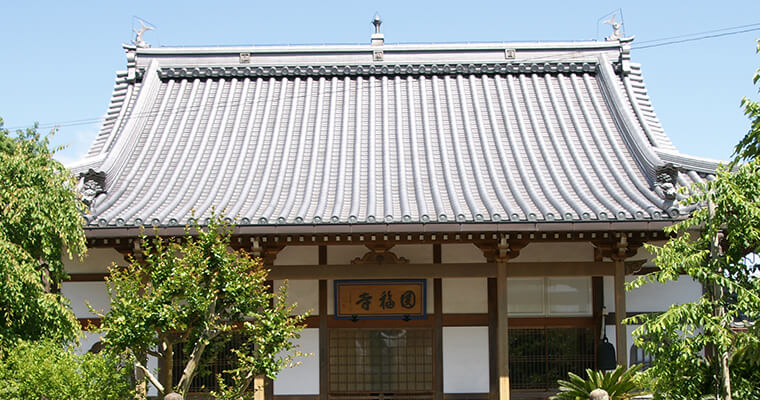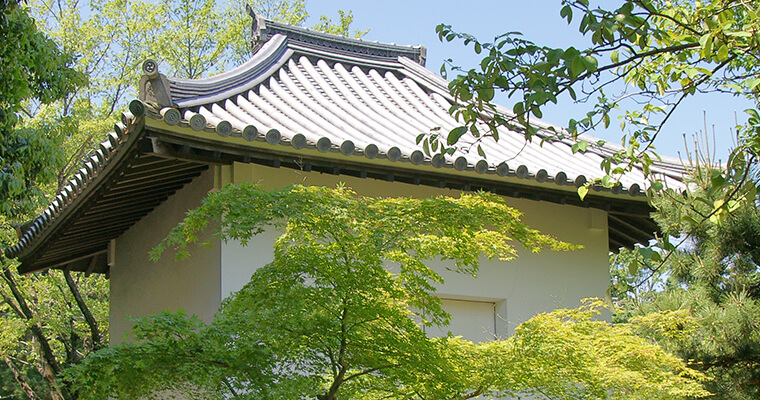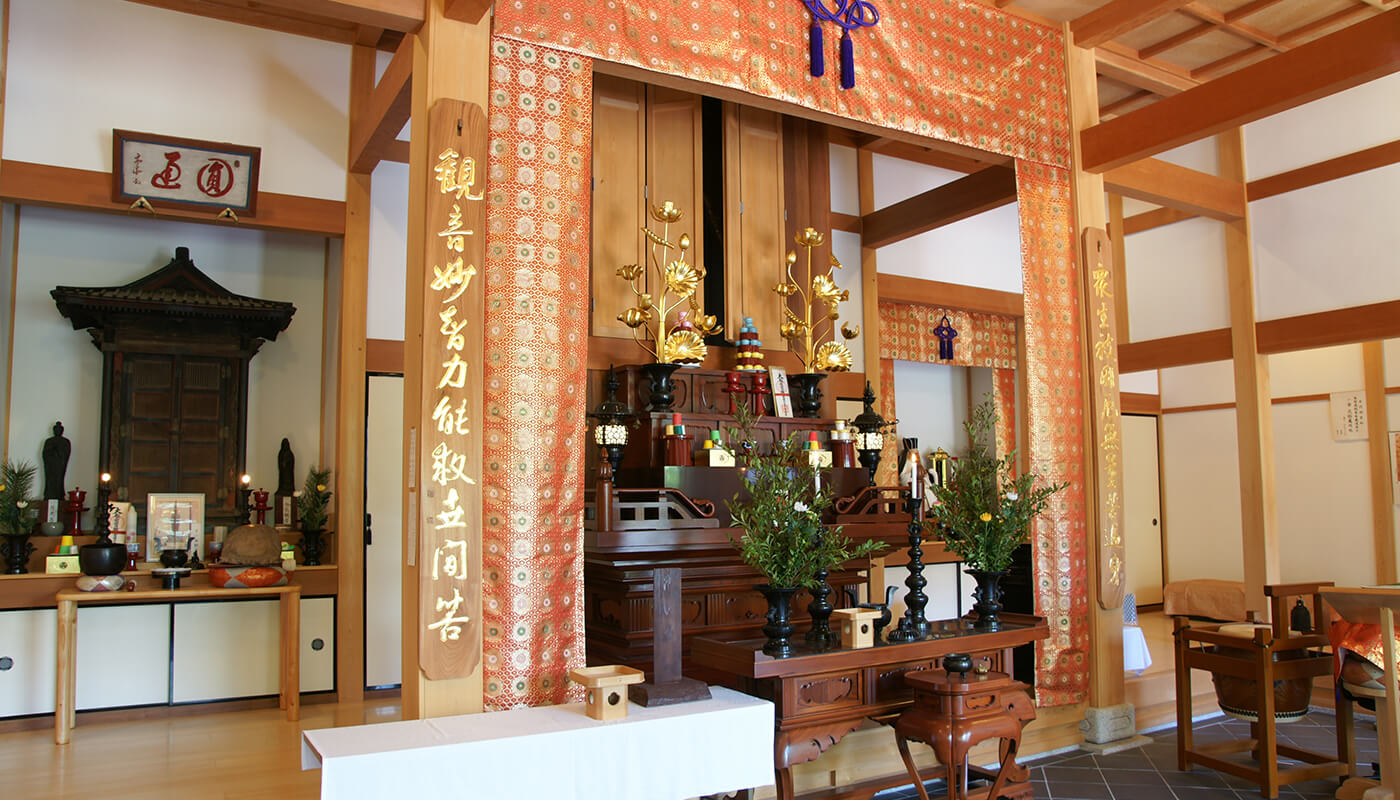Number 21Enpuku-ji temple
History of the temple
Seiyōzakki
Nisshozan Jūzan-ji is located around 2 ri distance north from Kameyama. It stands inside the village of Juzan. The main statue is a Jūichimen Kannon (Eleven-Faced Kannon). It is a temple number 20 of Ise Pilgrimage.
As deep as Buddha’s mercy the mountain stream of Jūzan-ji welcomes you when coming from afar.
According to the legend the temple was built at the beginning of the 9th Century. The main statue of Jūichimen Kannon (Eleven-Faced Kannon) was carved in the times of Emperor Saga (786-842) by a famous monk Gyōki (668-749), who traveled around Japan to preach to commoners. The Meditation Hall and a complete seven-structured temple compound construction followed. The temple was given a name Jūzan-ji.
In 1578 the temple was turned into ash by the forces of Oda Nobunaga, later regarded as the first “Great Unifier” of Japan. Fortunately the main statue was saved and moved to a small hall in the north-east part of the village. Because it went under protection of Shingon sect, the temple was not officially closed.
In 1676 the Lord of Kameyama Castle Itakura Shigetsune (1643-1688) invited a Chinese Zen monk Hakudō to help revive the temple and rebuilt Jūzan-ji in its former grounds. It became a branch temple of Ōbakusan Manpuku-ji – the head temple of Ōbaku sect of Zen Buddhism located in Uji, and changed its name to Nisshōzan Enpuku-ji. In 1678 a new main statue depicting Shō Kannon (Sacred Kannon) was made and a year later in 1679, together with Jūichimen Kannon the old main statue of Jūzan-ji temple, it was enshrined in a newly erected Kannon Hall. The Visitors Hall and abbot’s living quarters were donated by Sakanoue Iemon from Yamamoto village of Sesshū province. The old temple’s terrain was organized, a new road leading to the temple was built and the Main Gate was constructed. A pond with artificial islands was built within temple’s grounds. In 1701 a complete seven-structured temple compound in Zen style was finished.
In 1691 a compilation of basic Zen Buddhism texts edited by Tetsugen was offered by a monk Ryōō from Toeizan Mountain in Musashi province and placed in a newly built Sutra Hall. In 1696 the roof of Kannon Hall, which was covered with wood shingles, was changed to a roof covered with ceramic tiles. In 1716 a seriously damaged Kannon Hall was repaired thanks to Hokutan, a disciple of the 2nd abbot of the temple, who bought 30 pine trees for a total price of 100 ryo. In that year the temple’s name was reverted to Jūzan-ji, once again to be changed to Enpuku-ji some time later.
During the Edo period (1603-1868) the temple was protected and sustained by the Lords of Kameyama Castle. In 1679 the temple received a donation of land worth 5 koku (0.75t) of rice, 34.7ha (85.7ac) of mountains and forests and 1.8t of rice from Lord Itakura Shigetsune.
At the beginning of Meiji period (1868-1912) all high ranked monks left the temple and moved to Manpuku-ji in Uji. The temple was abandoned until 1899, when an abbot of Shinkō-in, a sub-temple of Manpuku-ji, moved to Kameyama, became a new abbot of Enpuku-ji and revived the temple once again.
Enpuku-ji changed drastically once again in the end of the 20th Century. As Ise Shimbun newspaper from 21st of August 1995 states: On the 20th of August at 0:35 in the night a fire started from the Main Hall. The 80m2 (861.1ft2) wooden building with a roof covered in tiles burned to the ground. Kobutsu Hall which was 20m2 (215.27ft2) and stood on the north east side of the Main Hall and enshrines the old Buddhist statue and other Buddhist utensils was also partially destroyed. Almost 800m2 (956yd2) of the forest growing at the mountain behind the Main Hall was also turned into ash. The fire died out after burning for around 1.5 hour. (abbrev.) The main statue of sitting Shō Kannon (wooden, 60cm, 23.6in), statue of Buddha Shakyamuni (previously worshiped in the Sutra Hall), statue of the founder of Enpuku-ji monk Hakudō as well as many other statues that were worshiped since the hall was rebuilt were all lost in the fire.
Currently a temporary hall has been built at the site of the Main Hall. It enshrines the old main statue of Jūichimen Kannon, which miraculously survived the fire untouched. The temple is planning to rebuild the lost Main Hall.

Outline
-
Honorific name
Nisshōzan
-
Temple's name
Enpuku-ji
-
Sect
Ōbaku Shinkō branch
-
Religious service
Shō Kannon
(Sacred Kannon)





